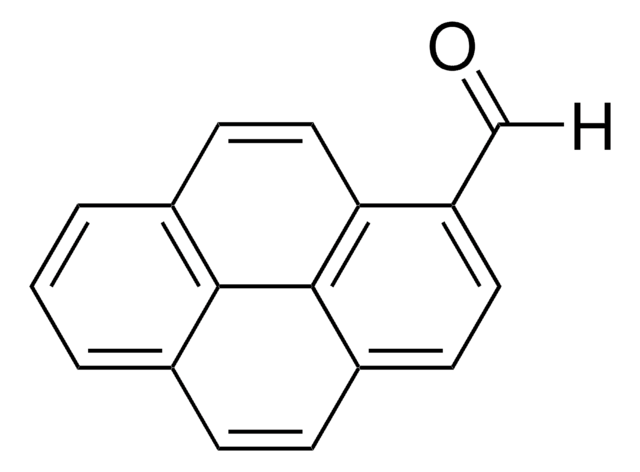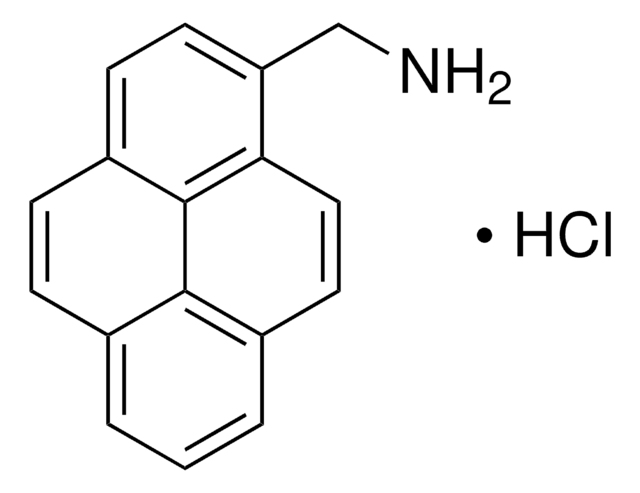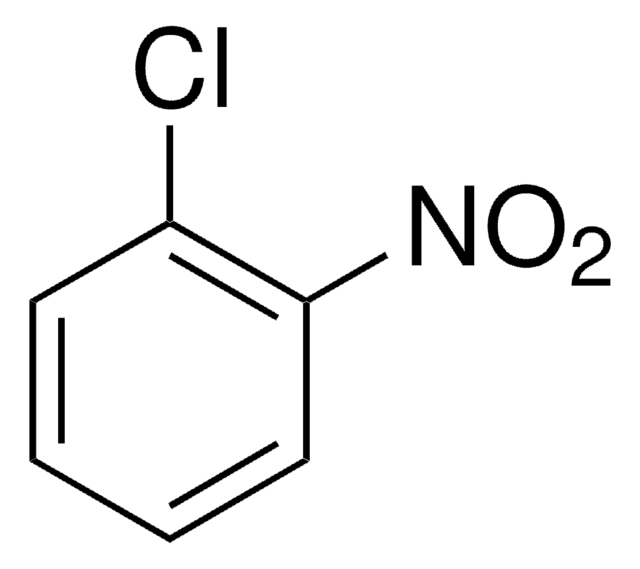284335
1,3-Dinitropyrene
99%
Autenticatiper visualizzare i prezzi riservati alla tua organizzazione & contrattuali
About This Item
Formula empirica (notazione di Hill):
C16H8N2O4
Numero CAS:
Peso molecolare:
292.25
Numero MDL:
Codice UNSPSC:
12352100
ID PubChem:
NACRES:
NA.22
Prodotti consigliati
Livello qualitativo
Saggio
99%
Forma fisica
solid
Solubilità
DMSO: soluble 2 mg/mL, clear, yellow to orange
Gruppo funzionale
nitro
Stringa SMILE
[O-][N+](=O)c1cc([N+]([O-])=O)c2ccc3cccc4ccc1c2c34
InChI
1S/C16H8N2O4/c19-17(20)13-8-14(18(21)22)12-7-5-10-3-1-2-9-4-6-11(13)16(12)15(9)10/h1-8H
KTNUVDBUEAQUON-UHFFFAOYSA-N
Categorie correlate
Descrizione generale
The carcinogenecity of 1,3-dinitropyrene was studied in newborn female rats.
Applicazioni
1,3-Dinitropyrene has been used in:
- modification of the umu-assay (ISO 13829) to assess the cytotoxic potential of toxins
- in vitro synthesis of 1,N6-etheno-2′-deoxyadenosine and 1,N2-etheno-2′-deoxyguanosine
Avvertenze
Warning
Indicazioni di pericolo
Consigli di prudenza
Classi di pericolo
Acute Tox. 4 Dermal - Acute Tox. 4 Inhalation - Acute Tox. 4 Oral
Codice della classe di stoccaggio
11 - Combustible Solids
Classe di pericolosità dell'acqua (WGK)
WGK 3
Punto d’infiammabilità (°F)
Not applicable
Punto d’infiammabilità (°C)
Not applicable
Dispositivi di protezione individuale
dust mask type N95 (US), Eyeshields, Gloves
Scegli una delle versioni più recenti:
Possiedi già questo prodotto?
I documenti relativi ai prodotti acquistati recentemente sono disponibili nell’Archivio dei documenti.
L B Tee et al.
Carcinogenesis, 9(10), 1869-1874 (1988-10-01)
Dinitropyrenes are mutagenic and carcinogenic environmental pollutants commonly found in diesel exhaust and airborne particulates. In the present study, the ability of rabbit lung to metabolize 1,8-dinitro[4,5,9,10-3H]pyrene by both oxygen-dependent and oxygen-independent pathways has been investigated. Using lung 9000 g
H Lee et al.
Mutation research, 324(1-2), 77-84 (1994-06-01)
The disposal of massive quantities of synthetic materials has become a very serious environmental problem around the world. When synthetic polymers are burnt or smolder in air, the combustion products are extremely complex, often consisting of several hundred compounds. In
A K Hajos et al.
Journal of biochemical toxicology, 6(4), 277-282 (1991-01-01)
The effect of highly purified rat liver cytosolic NAD(P)H-quinone oxidoreductase [EC 1.6.99.2] on the mutagenicity of 1,3- 1,6- and 1,8-dinitropyrene (DNP) was studied in the Ames Salmonella typhimurium mutagenicity assay. NAD(P)H-quinone oxidoreductase over the range of 0.02-0.8 micrograms/plate (38-1500) units
G W Winston et al.
Mutation research, 279(4), 289-298 (1992-06-16)
The effects of chronic ethanol feeding of rats on the ability of liver fractions to modulate the bacterial mutagenicity of three dinitropyrene isomers (1,3-, 1,6- and 1,8-DNP), which require bacterial enzymes but not an exogenous enzyme source for activation, were
C A Norman et al.
Carcinogenesis, 10(7), 1323-1327 (1989-07-01)
Formation of DNA adducts, following treatment of primary rabbit tracheal epithelial cells (RTEC) with 1,8-dinitropyrene (1,8-DNP) and its partially reduced derivative, 1-nitro-8-nitrosopyrene (1,8-NONO2), was examined using the 32P-post-labelling technique. Treatment of aerobic cells with 1,8-DNP or 1,8-NONO2 produced qualitatively similar
Il team dei nostri ricercatori vanta grande esperienza in tutte le aree della ricerca quali Life Science, scienza dei materiali, sintesi chimica, cromatografia, discipline analitiche, ecc..
Contatta l'Assistenza Tecnica.






![1-(6-Methoxybenzo[d] thiazol-2-yl)hydrazine AldrichCPR](/deepweb/assets/sigmaaldrich/product/structures/210/241/0c5be390-b73a-436d-82c7-c51156617e66/640/0c5be390-b73a-436d-82c7-c51156617e66.png)


